
Protomelas taeniolatus is a Haplochromine cichlid endemic to Lake Malawi in Eastern Africa. The fish is popular in the aquarium hobby due to the bright rainbow-like colors of adult males and its relatively peaceful temperament. Juvenile and female P. taeniolatus, like many Haplochromines, do not display bright coloration.

The firemouth cichlid is a species of cichlid fish native to Central America. They occur in rivers of the Yucatán Peninsula, Mexico, south through Belize and into northern Guatemala.
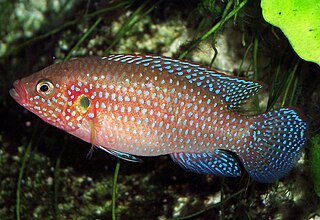
Hemichromis is a genus of fishes from the cichlid family, known in the aquarium trade as jewel cichlids. Jewel cichlids are native to Africa. Within West Africa, Hemichromis species are found in creeks, streams, rivers and lakes with a variety of water qualities including brackish water lagoons.
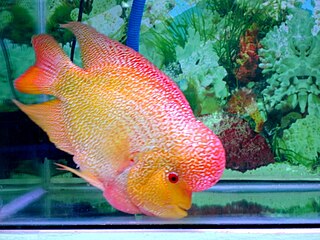
Flowerhorn cichlids are ornamental aquarium fish noted for their vivid colors and the distinctively shaped heads for which they are named. Their head protuberance, or etc, is formally termed a nuchal hump. Like blood parrot cichlids, they are man-made hybrids that exist in the wild only because of their release. Flowerhorns first emerged for sale on the aquarium market in Malaysia in the late 1990s and soon became popular in many countries in Asia. First developed in Malaysia, Thailand, and Taiwan, they became very popular with Asian fish hobbyists. They are also kept by hobbyists in the US, India and Europe. Numerous cast-off flowerhorns have been released to the wild, especially in Singapore and Malaysia, where they have become an invasive pest animal. Their importation is banned in Australia.
Nanochromis transvestitus is a sexually dimorphic cichlid endemic to Lake Mai-Ndombe in the Democratic Republic of the Congo where they live at a depth of around 1 metre (3.3 ft). It feeds on small benthic invertebrates. This species reaches a length of 3.4 centimetres (1.3 in) SL. Unusually for cichlids, it is the female, not the male, that is the most colourful. The female has a vertical black and white banding on her anal and caudual fins, with a bright red abdomen. The male, by contrast, is grayish in colour. Like many cichlids, the male does, however, have longer anal and caudal fins. The fish are egg layers and make a nest in the substrate in which to lay their eggs. This species is particularly threatened by the practice of using mosquito netting to catch fish out of the lake as material with holes that small catches every species of fish in the lake regardless of size. The specific name is a derived from the Latin trans meaning "cross" or "over" and vestitus meaning "clothed", a reference to the reversal of the normal sexual dimorphism in that this species has drabber males and more colourful females.

Pelvicachromis pulcher is a freshwater fish of the cichlid family, endemic to Nigeria and Cameroon. It is popular amongst aquarium hobbyists, and is most commonly sold under the name kribensis, although it has other common names, including various derivatives and color morphs of the kribensis: krib, common krib, red krib, super-red krib and rainbow krib, along with rainbow cichlid and purple cichlid.

Pseudocrenilabrus is a genus of fish in the family Cichlidae, commonly known as the mouthbrooders endemic to rivers and lakes in Central and Eastern Africa.
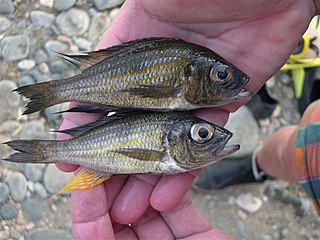
Aulonocranus dewindti is a species of cichlid endemic to Lake Tanganyika and some rivers which flow into it.

Nimbochromis livingstonii, Livingston's cichlid or (locally) kalingono, is a freshwater mouthbrooding cichlid native to Lake Malawi, an African Rift Lake. It is also found in the upper Shire River and Lake Malombe. They are found in inshore areas of the lake over sandy substrates.

The convict julie is a cichlid species in the subfamily Pseudocrenilabrinae family endemic to Lake Tanganyika. Hence it is found in Burundi, the Democratic Republic of the Congo, Tanzania, and Zambia. The fish is named after Charles Tate Regan.

The zebra mbuna is a species of cichlid endemic to Lake Malawi in Africa. This species can reach a length of 11.3 cm (4.4 in). It feeds on aufwuchs, a surface layer of mostly algal material that grows on rocks. This cichlid is a mouthbrooder and the female broods the eggs in her mouth for about three weeks. This fish can sometimes be found in the aquarium trade.
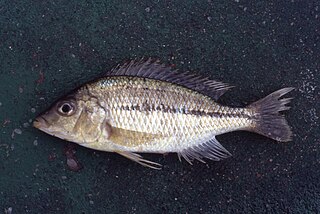
Protomelas kirkii is a species of cichlid endemic to Lake Malawi where it is most commonly found in areas vegetated with Vallisneria. This species can reach a length of 18 centimetres (7.1 in) TL. This species can also be found in the aquarium trade.
Pseudanthias heemstrai, the orange-headed anthias, Heemstra's anthias or redhead anthias is a species of marine ray-finned fish in the genus Pseudanthias, the subfamily Anthiinae of the family Serranidae, the groupers and sea basses. It is endemism to the Red Sea. It occasionally makes its way into the aquarium trade. It grows to a size of 13 cm in length.
Malapterurus beninensis is a species of electric catfish native to the African nations of Angola, Benin, Cameroon, the Democratic Republic of the Congo, the Republic of the Congo, Equatorial Guinea, Gabon, Ghana, Nigeria and Togo. This species grows to a length of 22 cm (9 in) SL. Its habitat is lowland marshes, rivers, and lakes.

Pelvicachromis sacrimontis is a freshwater fish of the cichlid family known only from a small area of southeastern Nigeria.Currently Fishbase considers this binomial to be a junior synonym of P. pulcher and, it was also known as Pelvicachromis camerunensis, P. pulcher "form B" or P. sp. aff. pulcher but some authorities now consider it to be a valid species. It is occasionally available in the tropical fish trade as "giant krib" and there are three colour morphs – red, green and yellow.

Pseudocrenilabrus philander or the southern mouth-brooder is a small species of haplochromine cichlid found in southern and central Africa. It was first described by the German-Dutch zoologist Max Carl Wilhelm Weber in 1897.
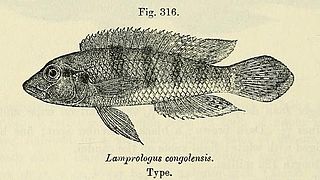
Lamprologus congoensis, the Congo lionhead cichlid is a species of riverine cichlid which is widespread in the Congo River, it is the type species of the genus Lamprologus.

The saddle cichlid is a species of cichlid from the tribe Cichlasomatini, part of the subfamily Cichlasomatinae from South America. It is the type species of the genus Aequidens. It is reasonably common in the aquarium trade.
Maylandia flavifemina is a species of haplochromine cichlid which is endemic to Lake Malawi.

Hemichromis letourneuxi is a species of cichlid which is native to West Africa and is popular in the aquarium hobby and it has been introduced to the Caribbean and the south-east United States where it is invasive.















